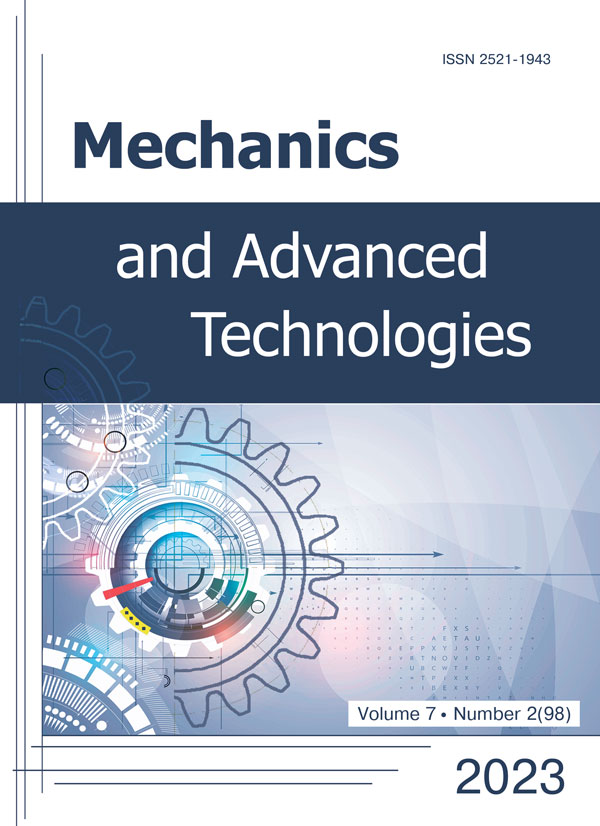Determination of elastic characteristics for a package of monolayers thin-walled plates from composite fibrous materials
DOI:
https://doi.org/10.20535/2521-1943.2023.7.2.287711Keywords:
composite materials, carbon tape, carbon fabric, multilayer thin-walled plates, elastic modulus, Poisson's ratios, plane stress state, Hooke's law, computational modelsAbstract
An analytical method for calculating the equivalent elastic characteristics of anisotropic multilayer plates made of composite fibrous materials is laid out. The main assumptions taken into consideration when calculating elastic moduli and Pousson's coefficients are that fibers are elastic materials with orthotropic mechanical characteristics that deform together when multilayer plates are loaded. Analytical methods for calculating effective modulus of elasticity most common in practical applications of applied mechanics are laid out in the list of cited publications. These include the rules of the mixture, the model proposed by Hill and Khashin, the model of Kilchinsky, the methods of Vanin and L.P. Khoroshun. Numerical methods for determining the elastic mechanical properties of reinforced unidirectional and layered composite materials are based on information technologies of finite-element modeling of representative volumes of composite materials and solving a number of boundary value problems for them. For the constructions of thin-walled plates with composite fibrous materials, traditional calculation schemes are used, for which the plane stress state is typical. The stress-strain relationship for a monolayer of plates loaded at an arbitrary angle is presented in the form of Hooke's law for aniotropic materials. Deformations of a package of monolayers with composite fibrous materials in a plane elastic-deformed state are determined, as for a monolayer, by four independent elastic constants. With the use of a universal calculation model based on the equations of applied mechanics, the results of the calculations of elastic moduli and Poisson's coefficients were obtained for a package of monolayers of thin-walled plates with composite fibrous materials made of carbon fiber and carbon fiber. Research results are presented in an analytical and graphic form. The influence of the construction structure of composite fibrous materials of thin-walled plates on its mechanical properties and their dependence on the angle of the force load vector is presented. The research results can be used to determine the rational mechanical properties of multilayer composite plates, taking into account their structural and technological purpose in various industries.
References
- Alan Baker, Stuart Dutton and Donald Kelly, Composite Materials for Aircraft Structures. Reston, Virginia: American Institute of Aeronautics and Astronautics, 2004, 597 p. Available: https://structures.dhu.edu.cn/_upload/article/files/f6/62/f5c6159f4c86ae7a86fbd6b48811/56d0064b-5f19-4602-b337-1441f8b103ee.pdf.
- M. Kryshchuk, S. Shukayev and V. Rubashevskyi, “Modeling of Mechanical Properties of Composite Materials Under Different Types of Loads”, in Nonlinear Mechanics of Complex Structures: From Theory to Engineering Applications. Cham: Springer International Publishing, 2021, pp. 39–56. DOI: https://doi.org/10.1007/978-3-030-75890-5_3.
- L. P. Kollar and G. S. Springer, Mechanics of composite structures. New York, USA: Cambridge University Press, 2003, 480 p. DOI: https://doi.org/10.1017/CBO9780511547140.
- H. M. Al-Shukri, M. S. Abdullateef and M. Z. Khelifa, “Mechanical properties comparison of four models, failure theories study and estimation of thermal expansion coefficients for artificial E-glass polyester composite”, Engineering and Technology Journal, vol. 29, no. 2, pp. 278–294, 2011. DOI: https://doi.org/10.30684/etj.29.2.8.
- M. Kucher and M. Zarazovsky, “Assessment of micromechanical models of prediction of effective elasticity constants of fibrous composites”, Bulletin of the National Technical University of Ukraine "Kyiv Polytechnic institute", Mechanical engineering series, no. 58, pp. 24–29, 2010.
- V. Rubashevskyi, M. Zarazovskii and S. Shukyev, “Determination of elastic constants of unidirectional layer in composite materials”, in Materials for use in extreme conditions - 6, Kiev, Ukraine, 2016, pp. 56–59.
- Yingjie Xu, Pan Zhang, Huan Lu and Weihong Zhang, “Hierarchically modeling the elastic properties of 2D needled carbon/carbon composites”, Composite Structures, vol. 133, pp. 148–156, 2015. DOI: https://doi.org/10.1016/j.compstruct.2015.07.081.
- B. W. Rosen, “Thermomechanical properties of fibrous composites”, Proceedings of the Royal Society of London, Series A, Mathematical and Physical Sciences, vol. 319, no. 1536, pp. 79–94, 1970. DOI: https://doi.org/10.1098/rspa.1970.0167.
- A. Kilchinsky, “On a Model for Determining the Thermoelastic Characteristics of Materials Reinforced by Fibers”, Applied Mechanics, vol. 1, no. 12, pp. 65–74, 1965.
- Mekhanika kompozitov, vol. 3: Statisticheskaya mekhanika i effektivnyye svoystva materialov, L. P. Horoshun Ed. Kyiv: Naukova dumka, 1993, 390 p.
- Zade S. Daria, “Numerical method for determining the effective characteristics of orthogonally reinforced composites”, Bulletin of the National Technical University “KhPI”, Series “Dynamics and strength of machines”, no. 58, pp. 71–77, 2013.
- K. Rudakov and V. Maslyey, “To a procedure of definition of the “equivalent” physico-mechanical characteristics of a honeycomb filler of a composite plate”, Mechanics and Advanced Technologies, vol. 84, no. 3 (84), pp. 75–85, 2018. DOI: https://doi.org/10.20535/2521-1943.2018.84.149780.
- N. A. Alfutov, P. A. Zinovyev and B. G. Popov, Raschet mnogosloynyh plastin i obolochek iz kompozitsionnykh materialov. Moskva: Mashinostroyeniye, 1984, 264 p.
Downloads
Published
How to Cite
Issue
Section
License
Copyright (c) 2023 Микола Крищук, Єгор Овчаренко, Ганна Ус

This work is licensed under a Creative Commons Attribution 4.0 International License.
Authors who publish with this journal agree to the following terms:
- Authors retain copyright and grant the journal right of first publication with the work simultaneously licensed under CC BY 4.0 that allows others to share the work with an acknowledgement of the work's authorship and initial publication in this journal.
- Authors are able to enter into separate, additional contractual arrangements for the non-exclusive distribution of the journal's published version of the work (e.g., post it to an institutional repository or publish it in a book), with an acknowledgement of its initial publication in this journal.
- Authors are permitted and encouraged to post their work online (e.g., in institutional repositories or on their website) prior to and during the submission process, as it can lead to productive exchanges, as well as earlier and greater citation of published work











